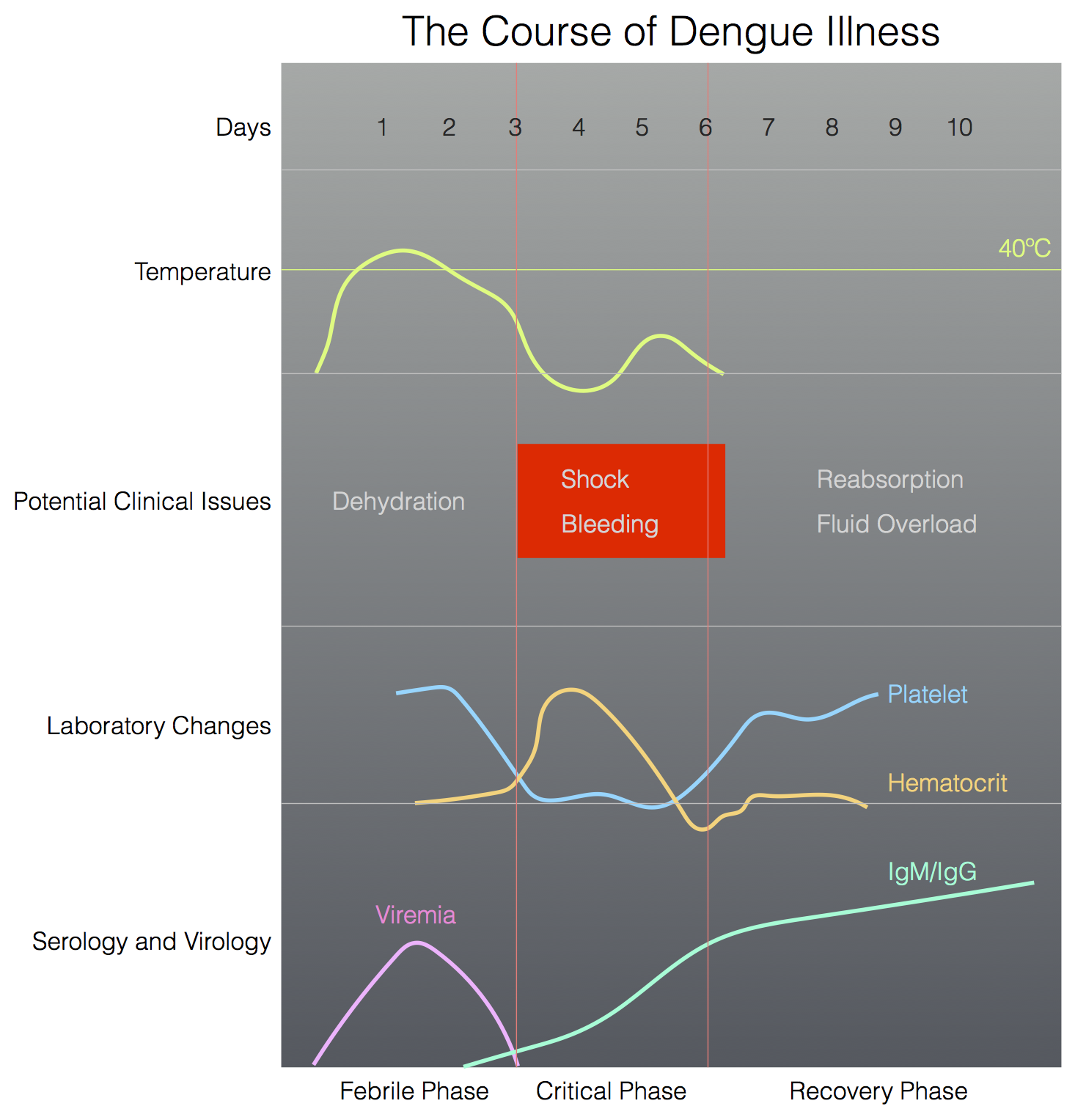Dengue fever laboratory tests
|
Dengue Fever Microchapters |
|
Diagnosis |
|---|
|
Treatment |
|
Case Studies |
|
Dengue fever laboratory tests On the Web |
|
American Roentgen Ray Society Images of Dengue fever laboratory tests |
|
Risk calculators and risk factors for Dengue fever laboratory tests |
Editor-In-Chief: C. Michael Gibson, M.S., M.D. [1]; Associate Editor(s)-in-Chief: Alonso Alvarado, M.D. [2]
Overview
The earliest abnormality in the complete blood count is decreased white cell count (leukopenia), which usually occurs during the febrile phase and should alert the physician to a high probability of dengue. The platelet count usually begins to drop when the temperature is returning to normal and is followed by findings indicative of plasma leakage such as elevated hematocrit level and hypoproteinemia. However, the extent of hemoconcentration may be affected by dilutional effect from excessive fluid administration or significant hemorrhage from the gastrointestinal tract and the white cell count may increase as a result of stress response. Serology and virology tests are used to confirm the diagnosis of dengue virus infection.
Laboratory Findings
 |
Complete Blood Count
- Progressive leukopenia (≤5000 cells/mm3) is the earliest laboratory abnormality in dengue virus infeciton. It is usually followed by an abrupt decline in the platelet count to about 100,000 cells/mm3 before the emergence of signs of plasma leakage.
- Rising hematocrit concentrations may suggest impending hemorrhage. Plasma leakage is heralded by a rising hematocrit above the baseline value, and the extent of hemoconcentration reflects the severity of plasma leakage. However, this may be obscured by excessive intravenous fluid administration or significant hemorrhage from the gastrointestinal tract. Frequent hematocrit determinations are essential for guiding intravenous fluid therapy.
- The hematocrit level normalizes or may be lower than the baseline due to the dilutional effect. The white cell count usually starts to rise soon after defervescence, while the recovery of the platelet count is typically delayed.
Metabolic Panel
- Hypoproteinemia, accompanied by fluid accumulation such as pleural effusions or ascites, may be evident.
- Metabolic acidosis, electrolyte disturbances, and abnormalities suggestive of organ dysfunction (including elevated aspartate transaminase, alanine transaminase, blood urea nitrogen, and creatinine) may occur as a result of tissue hypoperfusion associated with prolonged shock.
Laboratory Diagnostics
Virology and Serology Tests
- Although the diagnosis is generally clinical in endemic areas, a diagnosis of confirmed dengue infection is definitively established by isolation of the virus, detection of viral genome or NS1 antigen, or seroconversion of IgM or IgG (from negative to positive IgM/IgG or fourfold increase in the specific antibody titer) in paired sera.
- A positive IgM serology or a hemagglutination inhibition assay (HIA) antibody titer of 1280 or higher (or comparable figures by ELISA in a single specimen), are diagnostic of a probable dengue infection. Both probable and confirmed dengue cases should be notified to health authorities.[2]
| Definition | Method† | Interpretation† | Sample Characteristics |
|---|---|---|---|
| Confirmed Dengue Infection | Viral isolation | Virus isolated | Serum (collected at 1–5 days of fever) or necropsy tissues |
| Genome detection | Positive RT-PCR or positive real-time RT-PCR | ||
| Antigen detection | Positive NS1 Ag | ||
| Positive immunohistochemical | Necropsy tissues | ||
| IgM seroconversion | From negative IgM to positive IgM in paired sera | Acute serum (days 1–5) and convalescent serum (15–21 days after first serum) | |
| IgG seroconversion | From negative IgG to positive IgG in paired sera or 4-fold increase IgG levels among paired sera | ||
| Probable Dengue Infection | Positive IgM | Positive IgM | Single serum collected after day 5 |
| High IgG levels | High IgG levels by ELISA or hemagglutination inhibition assay (≥1280) |
† ELISA = enzyme-linked immunosorbent assay; IgG = immunoglobulin G; IgM = immunoglobulin M; NS1 Ag = non-structural protein 1 antigen; RT-PCR = reverse transcriptase polymerase chain reaction